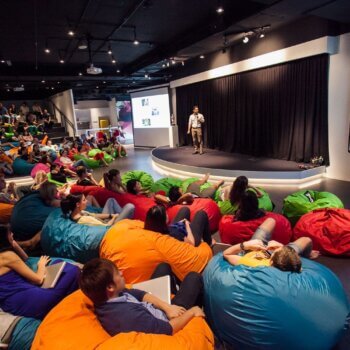Co-Working spaces are fast outpacing monolithic workspaces in terms of commercial real estate absorption in India. While the share of IT/ITeS in the share of transacted space is following a declining trend, co-working spaces are proliferating in the country.
Real estate services company, JLL estimates a 40–50% growth in flexible office space in India in 2018. In a recently released research report ‘Spotting the opportunities: flexible space in the Asia Pacific’, the company says that demand for flexible offices — including co-working spaces and serviced offices — is growing faster in the Asia Pacific than anywhere else in the world. It estimates that over 13 million people will work out of co-working spaces by 2020. The report further indicates, that the top 6 cities will require an estimated 5 million seats in co-working spaces, while, 8.5 million of the projected demand will be in Tier 2 and 3 cities.
The trend is in consonance with the demographic distribution in India. By 2020, the average age in India will be 29 and it is set to become the world’s youngest country with 64% of its population in the working age group. Both Millennials (those born between the early 1980s and mid-1990s) and Post-Millennials seem to prefer operating from co-working spaces.
Enterprises adapting to the Future of Work
While co-working spaces are often associated with startups, they are currently the smallest segment occupying such spaces. Enterprises account for the largest share of co-working space occupied. Generally enterprises are adopting shared workplaces as a means to inject agility into their overall real estate strategies.
Companies like Microsoft, General Electric, Truecaller, GoDaddy, Twitter, Vice Media, Jaguar Land Rover have specialised teams and divisions operating out of co-working spaces in India currently.
According to JLL Research, one of the key drivers of the surge in corporate demand for flexible spaces is plug-and-play simplicity,particularly for larger companies. The ability to move in and out of an office at short notice, avoid complicated contract negotiations and fit-out work is a convenient option for many occupiers. At the same time, businesses are looking to encourage collaboration among employees and are using shared work-spaces as a way to foster innovation through exposure to new ideas and ways of working.
The potential market size of co-working across India is expected to be 13.5 million users by 2020 about half of which will be from enterprises, which are expected to take up 10.3 mn seats. Freelancers and Small & Medium Enterprises (SMEs) are expected to contribute 1.5 million users worth of demand, while it is anticipated that startups will demand up to 100,000 seats by 2020.
According to a report by JLL Research, the maximum (nearly 70%) business opportunity here lies with large corporate firms seeking alternative, activity-based workplaces to nurture their talent and further their business growth. The small, emerging business sector (~20%) follows as the second demand group looking for hot desking opportunities at lowcost shared workplaces, while professional freelancers and start-ups form the rest (~10%) of the market demand.
More Office Spaces becoming Co-working Spaces
In 2017, nearly 1.1 million people worked at the 13,800 coworking spaces around the world, according to the 2017 Global Coworking Survey by Deskmag.
“From 600 centres in 2010 to 18,900 centres in 2018, co-working has come a long way. The Indian market is not dissimilar to global market conditions,” says Dr. Lee Elliott — Global Head of Occupier Research, Knight Frank. He said that Productivity, Technology, Changing Corporate Constitutions, Space as a service, Heightened Mobility & M&A Activities would be the 5 themes for next 5 years.
“We have seen the emergence of co-working spaces in a big way. It represented about 8% of office space absorption in 2017 compared to the previous year’s share of 3%. Technologies such as automation/artificial intelligence could replace traditional job roles in industries such as IT and BFSI. A loss in jobs and a change in the work culture are likely to have an impact on the way companies lease or buy office space,” said Nimish Gupta, Managing Director, RICS South Asia (The Royal Institution of Chartered Surveyors).
Knight Frank India, in the ninth edition of its half-yearly report, indicated that co-working service providers accounted for 13 percent of the total transacted space (across seven cities) for the period January — June 2018 (H1 2018). In Bangalore alone, co-working spaces garnered 19 percent of the total H1 2018 transactions, of a total transaction volume of 0.61 mn sq m or 6.5 mn sq ft. Over all, the share of IT/ITeS in the share of transacted space is following a declining trend.
“In India, the co-working segment is expected to grow by 40–50% in 2018 alone. By the end of the year, we anticipate flexible workplaces would attract investment up to US$ 400 mn. With over 200 premium business centers across the country, set to double by 2020, co-working spaces will reflect the global trend of being closer to 20% of total workspace”, mentioned Sandeep Sethi — MD, Integrated Facilities Management West Asia, JLL.
“By 2030, flexible workspaces could comprise 30 percent of corporate commercial property portfolios worldwide,” said Jeremy Sheldon, Managing Director, Markets & Integrated Portfolio Services, JLL Asia Pacific. “Although corporate adoption is still in its early days, there are certain factors that will continue to make this region a hot spot for co-working growth.”
“Flexibility has become an interesting and appealing aspect in co-working. Co-working will co-exist with conventional office spaces : conventional spaces will start looking and feeling like co-working spaces,” said Dr. Lee Elliott. According to him, 30 percent of occupiers said in the survey that there was no real estate cost benefit. Less than 40% of the respondents said they would regard enterprise solutions in the next 3 years in their business.
Currently, most of the coworking spaces (over 95%) in India function out of rented properties, which is in line with the global average. Most shared office operations in India are also currently dominated by domestic players (almost 90%), with global operators just beginning to make an entry into the marketplace. Alternative spaces like restaurants are also doubling up as co-working spaces.
According to JLL, landlords will continue to form joint ventures with co-working operators or create their own flexible space offerings to meet tenants’ needs. Meanwhile, developers are adapting to what could be a new standard in property development whereby flexible work-space will be an amenity as essential in a commercial building as food and beverage outlets or a gym.
Colliers Research forecasts that commercial real estate is likely to dominate the real estate investment in coming years. A report by Colliers indicates that India witnessed investment transactions totalling to INR156 billion (USD2.4billion) in H1 2018, up 26% compared to H1 2017 (USD1.9billion). The commercial segment dominating with global players such as Blackstone, Brookfield, Xander, etc. remained bullish on investment in commercial real estate in H1 2018. With increasing investment, the CRE market has also started witnessing profound structural changes in the way commercial real estate is built, financed and managed. According to Colliers research the change in ownership from local developers to institutional investors and advent of REITs should lead to the institutionalisation of the CRE in the next three years.
With co-working still being at its early inception stages, specialisation and focus will help differentiate the co-working players.
About the Author
This article was written by Arjun G, Editor of REDACT. see more.





























